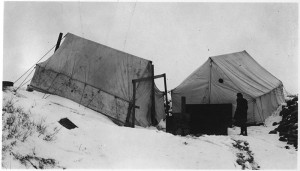 Camping in summer is perfect: a chance to shake off the stale atmosphere in your (probably) air-conditioned home. You live simple, work hard, sleep well and wake up a little sore.
Camping in summer is perfect: a chance to shake off the stale atmosphere in your (probably) air-conditioned home. You live simple, work hard, sleep well and wake up a little sore.
And camping in winter seems deranged. Correction: winter camping in the north, or at altitude, seems mad. This is true when you’re twenty, and it’s truer when you reach an age where your circulation isn’t as good as it was. But people do it and love it. If you set aside your prejudices—and pick up the right gear—you can probably see why.
Because most people assume that high-tech tools are better, and because no one wants to haul a 60-pound pack on snowshoes, ultralight gear seems ideal for winter camping. And some very good companies are making and selling ultralight cold-weather gear. Tents, tarps, bags, stoves.
Look at Kifaru, a company that sells to the military and hardcore outdoors-people. The floorless ParaTipi is light (3.5 pounds) and it accepts the company’s wood-burning stove. (Note that the website is ominously quiet on the stove weight.) Together, they cost around $800. For more weight (almost 6 pounds) but less money (around $300), Sierra Designs has a floorless shelter—the Mountain Guide Tarp—with snow flaps on the fly. No stove, though.
If you’re sleeping in a floorless shelter, you’ll want a ground cover and pad. Or two. And a nice thick bag. We’ve never tested, so can’t recommend Mountain Hardware’s Ghost bag, but it’s a little over 5 pounds of down, which explains how it earns its -40° rating.
But what if high-tech isn’t always best? If you’re schlepping a stove, you’ve given up on the notion of ultralight, and there are benefits to be gained by going retro. Throw your creature comforts—including a roomy canvas tent—on a toboggan like these guys and grind your way to a snowbound lake. You’ll be warm and dry. And happy in the woods. (Don’t miss the video.)
You’ll need to be fit to start, but there’s a good chance you’ll be fitter when you’re done. You’ll also be lighter: “A person who usually requires a 2,000-calorie daily diet needs to consume up to 6,000 calories in deep cold conditions.”
Photo: Camp tents (c. 1938) at the Standing Rock Agency, Department of the Interior, Bureau of Indian Affairs, via Wikimedia Commons.









